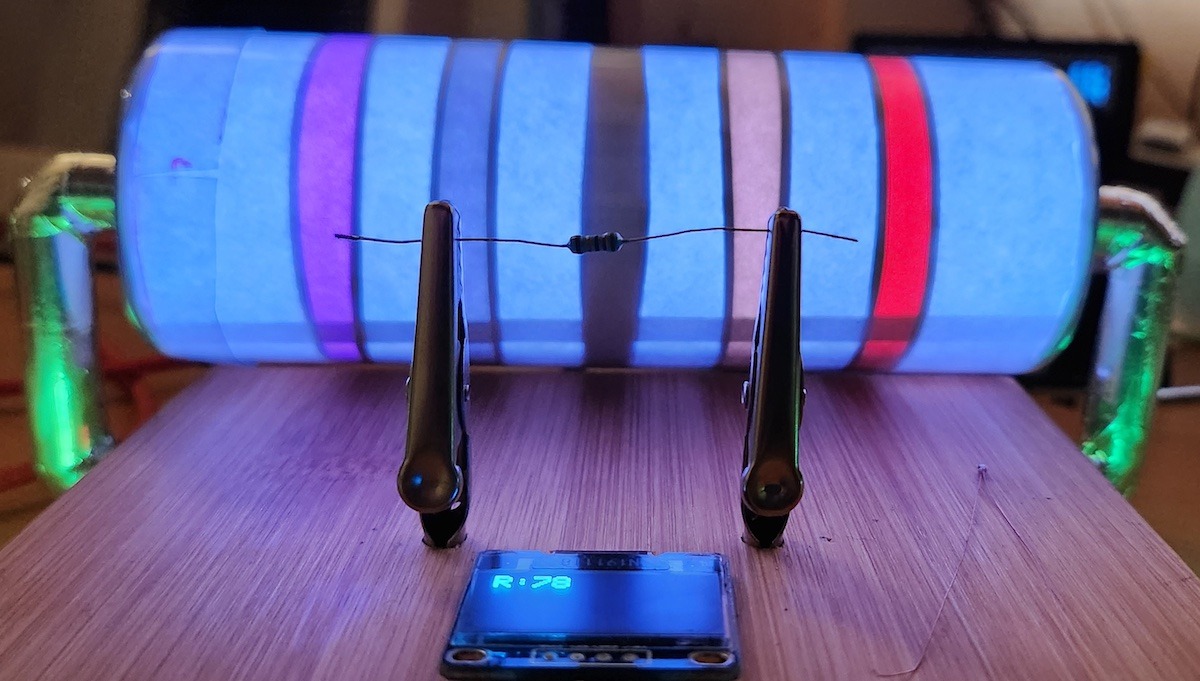The Great Resistor lamp makes color codes readable
The Great Resistor lamp makes color codes readable
Arduino Team — November 5, 2022

Resistor color codes are great because they make it easy to identify the value of a resistor by referring to a simple chart (or memorizing that chart). But the resistors are also very small and their color bands are difficult for many of us to see clearly. Instead of buying a magnifying glass, J built the Great Resistor lamp which reproduces the color code of a resistor on a much larger scale.
To display the value of a resistor, you must first find this value. To measure the resistance of unknown resistors, J used an Arduino Nano and a 16-bit ADC (analog-to-digital converter) to measure the input and output voltages of a voltage divider circuit. One of the resistors in this circuit has a known value, while the second is the unknown resistor under test. The three known values allow the Arduino to calculate the unknown value, which is the resistance of the resistor under test.

The Great Resistance then displays the value of the resistance in two ways. First, it displays the numeric value on a small 0.96" monochrome OLED display. Second, it illuminates NeoPixel RGB LEDs in a tube to match the color bands of the resistor. Each color band section is sits between foam spacers to isolate the colors. The Arduino determines the colors by looking at the first three digits of the resistor, which correspond to the first three bands. The fourth band is the multiplier. The fifth band specifies the tolerance of the resistor. , though it's not clear how the large resistance determines this tolerance or if J always sets it to red (a loose tolerance).

Arduino Team — November 5, 2022

Resistor color codes are great because they make it easy to identify the value of a resistor by referring to a simple chart (or memorizing that chart). But the resistors are also very small and their color bands are difficult for many of us to see clearly. Instead of buying a magnifying glass, J built the Great Resistor lamp which reproduces the color code of a resistor on a much larger scale.
To display the value of a resistor, you must first find this value. To measure the resistance of unknown resistors, J used an Arduino Nano and a 16-bit ADC (analog-to-digital converter) to measure the input and output voltages of a voltage divider circuit. One of the resistors in this circuit has a known value, while the second is the unknown resistor under test. The three known values allow the Arduino to calculate the unknown value, which is the resistance of the resistor under test.

The Great Resistance then displays the value of the resistance in two ways. First, it displays the numeric value on a small 0.96" monochrome OLED display. Second, it illuminates NeoPixel RGB LEDs in a tube to match the color bands of the resistor. Each color band section is sits between foam spacers to isolate the colors. The Arduino determines the colors by looking at the first three digits of the resistor, which correspond to the first three bands. The fourth band is the multiplier. The fifth band specifies the tolerance of the resistor. , though it's not clear how the large resistance determines this tolerance or if J always sets it to red (a loose tolerance).
What's Your Reaction?






















